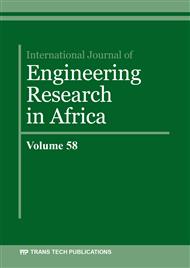[1]
Ashokkumar D, Study of Quality Management in Construction Industry, Int J Innov Res Sci Eng Technol. 2014; 3(1):36–43.
Google Scholar
[2]
Neyestani B, Effectiveness of Quality Management System (QMS) on Construction Projects, SSRN Electron J. 2017; (76754).
Google Scholar
[3]
Mallawaarachchi H, Senaratne S, Importance of Quality for Construction Project Success, 6th Int Conf Struct Eng Constr Manag. 2015; 84–9.
Google Scholar
[4]
Hosseini SA, Akbarpour A, Ahmadi H, Aminnejad B, Balance of Cost, Time, and Quality Related to Construction Projects Regarding the Reinforced Concrete of Underground Structures using a Meta-Heuristic Algorithm, Arch Civ Eng. 2017; 63(4):103–21.
DOI: 10.1515/ace-2017-0043
Google Scholar
[5]
Hassan Z, Ibrahim A, Naji H, Evaluation of Legislation Adequacy in Managing Time and Quality Performance in Iraqi Construction Projects- a Bayesian Decision Tree Approach, CE.J. 2018; 4(5):993.
DOI: 10.28991/cej-0309151
Google Scholar
[6]
Dale B, Oakland J, Quality Improvement through Standards. S, Thornes Publishers, England, UK. (1994); 40-43.
Google Scholar
[7]
Dale B, Plunkett J, Quality Costing, 3rd ed., Gower Publishing Limited, Hampshire, England, UK. (1999); p.9, 27, 32, 38, 48, 53, 143.
Google Scholar
[8]
Feigenbaum A, Total Quality Control, Harvard Business Review, (1956); 34(6): 93-101.
Google Scholar
[9]
Crosby P, Puti F, Wisridani M, Quality Assurance, McGraw Hill Custom Publishing, (1979); 380.
Google Scholar
[10]
Aoieong R, Capturing Quality Costs of Construction Processes Using the Construction Process Model (CPCM), PhD Thesis, Department of Civil and Structural Engineering, The HongKong Polytechnic University, HongKong. (2004).
Google Scholar
[11]
Love P, Irani Z, A Project Management Quality Cost Information System for the Construction Industry, Information & Management. (2003); 40: 649-661.
DOI: 10.1016/s0378-7206(02)00094-0
Google Scholar
[12]
Abramsson P, Edmark S, Ewers S, Falk E, Ullmar E, Josephson P, Poor Quality Costs in Large Construction Companies: What Can be Learned from Other Industries?, The CRIOCM International Symposium on Advancement of Construction Management and Real Estate. (2013); http://www.irb.net.de/daten/iconda/CIB5838.pdf.
Google Scholar
[13]
Tawfek H, Mohammed H, Abdel Razek M, Assessment of the Expected Cost of Quality (COQ) in Construction Projects in Egypt Using Artificial Neural Network Model, HBRC J. (2012); 8: 132-143.
DOI: 10.1016/j.hbrcj.2012.09.009
Google Scholar
[14]
Lam S, Low C, Teng W, ISO 9000 in Construction, McGraw-Hill Book Co. (1994); p.21.
Google Scholar
[15]
Abdul Rahman H, The Cost of Non-Conformance During a Highway Project: A Case Study, Construction Management and Economics. (1995); 13: 23-32.
DOI: 10.1080/01446199500000004
Google Scholar
[16]
Kamal S, Manoj K, Latin hypercube sampling based NSGA-III optimization model for multimode resource constrained time–cost–quality–safety trade-off in construction projects, International Journal of Construction Management. (2020).
DOI: 10.1080/15623599.2020.1843769
Google Scholar
[17]
Nima H, Mohammad E, Javad S, Presenting a goal programming model in the time-cost-quality trade-off, International Journal of Construction Management. (2018).
Google Scholar
[18]
Ossama H, Mahmoud E, Stochastic Time-Cost-Quality Trade-Off Analysis: The PERT Approach, Construction Research Congress. (2018).
DOI: 10.1061/9780784481271.034
Google Scholar
[19]
Duc-Long L, Duc-Hoc T, Phong T,Optimizing multi-mode time-cost-quality trade-off of construction project using opposition multiple objective difference evolution, International Journal of Construction Management. (2018).
DOI: 10.1080/15623599.2018.1526630
Google Scholar
[20]
Abhilasha P, Kumar N, Integrating Quality and Safety in Construction Scheduling Time-Cost Trade-Off Model, the Journal of Construction Engineering and Management. November 22 (20201).
Google Scholar
[21]
Allan C, Ivan M, Quality Assurance and Quality Control of High-Rise Enclosure Design Using Lean Principles, The Practice Periodical on Structural Design and Construction, October 29, (2019).
DOI: 10.1061/(asce)sc.1943-5576.0000463
Google Scholar
[22]
Syed W, Ilker B, Yogesh K, Emin K, Development of Pay Factors to Regulate Chip Seal Construction Quality, Airfield and Highway Pavements. (2019).
DOI: 10.1061/9780784482452.016
Google Scholar
[23]
Ayman M, Sami G, Framework to Optimize Cost of Quality in Delivering and Operating Green Buildings, International Conference on Sustainable Infrastructure, (2019).
DOI: 10.1061/9780784482650.035
Google Scholar
[24]
Peter E, Pauline T, John M, Revisiting Quality Failure Costs in Construction, Journal of Construction Engineering and Management, April 25, (2018).
Google Scholar
[25]
Saša B, Andy K, A Critical Success Factor Framework for Information Quality Management, Information Systems Management, 31:276–295, (2014).
DOI: 10.1080/10580530.2014.958023
Google Scholar
[26]
Olugbenro O, Chukwuma N, Armen A, Application of Emerging Technologies for Highway Construction Quality Management: A Review, Construction Research Congress (2020).
Google Scholar
[27]
Iman S, Ehsan E, Farnad N, Shiva A, Dynamic modeling to reduce the cost of quality in construction projects, International Journal of Construction Management, (2020).
Google Scholar
[28]
James T, Hyun J, Analyzing the Quality Problems and Defects of Design Deliverables on Building Projects, Journal of Architectural Engineering, July 24, (2020).
Google Scholar
[29]
Al-Tmeemy S, Abdul-Rahman H, Harun Z, Contractors' Perception of the Use of Costs of Quality System in Malaysian Building Construction Projects, International Journal of Project Management. (2012); 30(7): 827-838. (.
DOI: 10.1016/j.ijproman.2011.12.001
Google Scholar
[30]
BSI (British Standards Institution), BS 6143: Part 2 Guide to the Economics of Quality-Preventive, Appraisal and Failure Model, British Standards Publishing. (1990).
Google Scholar


